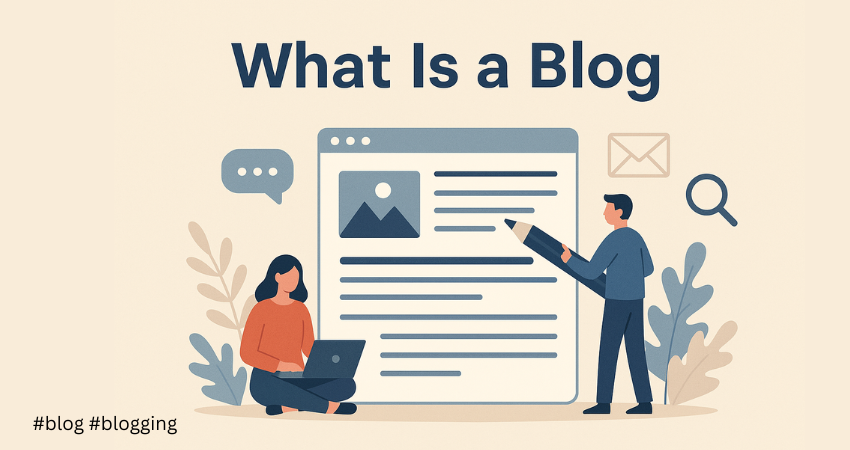You’ve probably come across blog posts while Googling something simple—like “how to write a pitch email” or “best tools for freelance writers.” But have you ever paused to think, what exactly is a blog? Is it just another form of writing? Or is it something more?
For many freelancers, small businesses, and personal brands, blogging is more than just publishing articles. It’s a tool to share insights, attract readers, showcase expertise, and yes—build an income stream. And if you’re just starting out or switching lanes in your writing career, understanding the purpose of a blog (and how it’s different from content writing) can make all the difference.
This post is your beginner-friendly guide to what blogging really is, how it fits into the broader content landscape, and the 9 types of blogs you should know before hitting “publish.”

Table of Contents
ToggleKey Takeaways
- A blog is your digital voice.
It helps you connect with your audience, showcase expertise, and grow your brand or career. - Blogging isn’t the same as content writing.
Blogs are one form of content writing—more personal, educational, and story-driven. - Choosing the right blog type matters.
Knowing your blog’s purpose—whether it’s niche, personal, or professional—helps shape your content and attract the right readers.
So, What Is a Blog?
A blog is a regularly updated section of a website—or a standalone site—where individuals or businesses publish content in the form of articles (called blog posts). These posts are usually focused on a specific topic or theme, and are written in a conversational, informative, or storytelling tone.
At its core, a blog is a tool for:
- Sharing ideas or experiences
- Educating or guiding a specific audience
- Building credibility in a chosen field
- Attracting traffic through search engines and social shares
Unlike static web pages, blogs are dynamic—they grow with time, adapting to the writer’s voice, goals, and audience needs.
In plain terms:
A blog is your digital space to talk to your audience. It could be about content strategy (like here on mayapillaiwrites.com), writing tips, branding advice, or simply documenting your journey as a freelancer.
How Blogging Is Different from Content Writing
Let’s clear something up—blogging and content writing are not the same, even though they often overlap. Content writing is a broader umbrella that includes all types of written material created for digital platforms: website copy, product descriptions, newsletters, social media captions, case studies, and more. Blogging, on the other hand, is a specific type of content writing that typically focuses on educating, informing, or engaging an audience through longer-form articles published on a blog section of a website.
While content writing is often structured for conversion or performance (e.g., getting someone to buy, sign up, or click), blog writing is more reader-centric—it aims to build trust, deliver value, and encourage repeat visits. Blogs allow for a personal voice, storytelling, and perspective that might not always fit in a more formal or transactional piece of content. For example, a blog post might explore “Why Freelancers Should Build a Personal Brand,” while content writing might involve writing a homepage section titled “About Our Team.”
Both are essential in a digital strategy—but they serve different goals, formats, and tones.
Aspect | Blogging | Content Writing |
Goal | To inform, engage, or guide readers | To market, convert, sell, or explain |
Tone | Friendly, opinion-based, or story-driven | Varies—can be formal, persuasive, technical, or concise |
Format | Articles posted on websites | Includes blog posts, website copy, emails, product pages, etc. |
SEO Importance | High—especially for traffic | Very high across most formats |
Reader Interaction | Common—through comments or shares |
9 Common Types of Blogs (with Real-Life Examples)
Whether you’re planning to build your authority, grow an audience, or just document your journey, the type of blog you choose will shape your voice, tone, and reach. Here are the most popular blogging types—with examples to help you visualise the possibilities.
1. Personal Blogs
These are intimate, reflective spaces where writers share thoughts, life experiences, lessons learned, and personal stories.
Examples:
- Cup of Jo – A lifestyle and motherhood blog that feels like chatting with a friend.
- Zen Habits by Leo Babauta – Focused on mindfulness, simplicity, and intentional living.
- Rukmini Ray Kadam’s blog – Indian blogger writing about everyday reflections, writing, and life.
2. Professional or Business Blogs
Used by solopreneurs or businesses to position themselves as experts, attract leads, and provide valuable insights to potential clients.
Examples:
- Neil Patel’s Blog – A digital marketing hub for SEO, content, and growth strategies.
- FreshBooks Blog – Covers productivity, invoicing, and freelance finance management.
- Mayapillaiwrites.com – Offers guidance to content writers and builds an ecosystem for writers and clients.
3. Niche Blogs
These cater to a specific audience or interest area. The more focused the topic, the more targeted the readers.
Examples:
- The Review Hive – A cybersecurity-focused blog covering software reviews and industry updates.
- Minimalist Baker – Specialises in simple, plant-based recipes for home cooks.
- Mr. Money Mustache – Focused exclusively on financial independence and frugal living.
4. Affiliate Blogs
These blogs earn through commissions by recommending products or services through tracked affiliate links. They often focus on reviews, listicles, or comparison posts.
Examples:
- The Wirecutter (by NYT) – Recommends tech and home products with detailed reviews.
- TechRadar – Reviews gadgets, software, and tech services with affiliate links.
- ShoutMeLoud by Harsh Agrawal – Covers blogging tools and affiliate marketing strategies.
5. Educational Blogs
These blogs are built to teach, train, and offer actionable resources—especially valuable for service-based businesses or creators.
Examples:
- Copyblogger – Offers lessons on persuasive writing, copywriting, and content strategy.
- HubSpot Blog – Covers inbound marketing, sales funnels, and CRM education.
- ProWritingAid Blog – Teaches grammar, editing techniques, and writing best practices.
6. News and Commentary Blogs
These keep readers up to date with trends, current events, or offer strong viewpoints on recent happenings in a particular industry.
Examples:
- Search Engine Journal – News on Google algorithm updates and digital marketing.
- TechCrunch – Tech startup news and industry trends.
- Cybersecurity News section on The Review Hive – Covers ransomware, scams, and breach reports for small businesses.
7. Portfolio Blogs
Ideal for creatives—especially writers, designers, photographers, and consultants—who want to showcase their work and build trust with potential clients.
Examples:
- Sonia Thompson’s Brand Portfolio – Showcases client projects and storytelling case studies.
- Ashlyn Writes – A copywriter’s blog and portfolio with strong branding appeal.
- The Pudding – A visual storytelling blog showcasing data journalism and writing design.
8. Guest Contributor Blogs
These platforms feature content from multiple voices and perspectives. Great for building networks, SEO authority, and fresh perspectives.
Examples:
- Medium Publications like Better Marketing or The Writing Cooperative – Accept submissions from global contributors.
- Moz Blog – Shares SEO and marketing insights from both internal and guest experts.
- Smashing Magazine – Accepts developer- and design-focused guest submissions.
9. Microblogs
Short, punchy, snappy posts—often visual—shared on platforms that prioritise bite-sized or aesthetic content.
Examples:
- Tumblr blogs like Humans of New York – Focused on storytelling in short formats.
- LinkedIn Articles – Microblogs for professionals on trends, ideas, and opinions.
- Instagram captions from @bloggerkashmiralad/ – Share reflections, quotes, and tips in a visually engaging, brief format.
Why This Matters for You as a Writer
Whether you want to:
- Attract freelance clients
- Build a niche writing brand
- Share your expertise
- Or simply put your thoughts out into the world…
…your blog becomes your voice and value on the internet.
It gives you:
- A home to showcase your skills
- A platform to build authority
- A space to grow your audience
And in time, your blog can turn into something bigger—like a product, a newsletter, a client magnet, or even a community.
